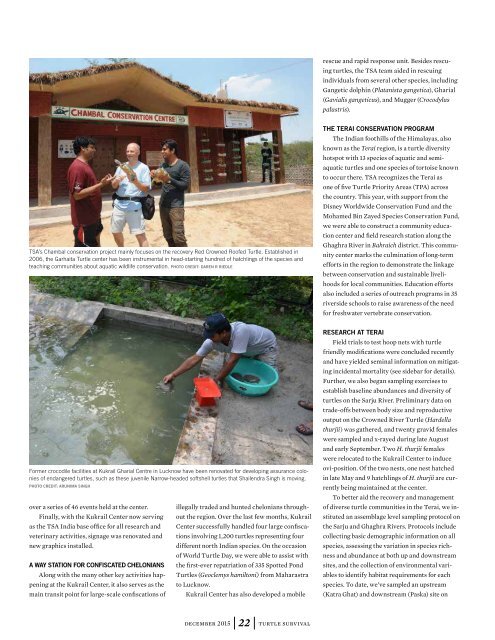Turtle Survival
2tUaeTbNi
2tUaeTbNi
Create successful ePaper yourself
Turn your PDF publications into a flip-book with our unique Google optimized e-Paper software.
escue and rapid response unit. Besides rescuing<br />
turtles, the TSA team aided in rescuing<br />
individuals from several other species, including<br />
Gangetic dolphin (Platanista gangetica), Gharial<br />
(Gavialis gangeticus), and Mugger (Crocodylus<br />
palustris).<br />
TSA’s Chambal conservation project mainly focuses on the recovery Red Crowned Roofed <strong>Turtle</strong>. Established in<br />
2006, the Garhaita <strong>Turtle</strong> center has been instrumental in head-starting hundred of hatchlings of the species and<br />
teaching communities about aquatic wildlife conservation. PHOTO CREDIT: DAREN R RIEDLE<br />
THE TERAI CONSERVATION PROGRAM<br />
The Indian foothills of the Himalayas, also<br />
known as the Terai region, is a turtle diversity<br />
hotspot with 13 species of aquatic and semiaquatic<br />
turtles and one species of tortoise known<br />
to occur there. TSA recognizes the Terai as<br />
one of five <strong>Turtle</strong> Priority Areas (TPA) across<br />
the country. This year, with support from the<br />
Disney Worldwide Conservation Fund and the<br />
Mohamed Bin Zayed Species Conservation Fund,<br />
we were able to construct a community education<br />
center and field research station along the<br />
Ghaghra River in Bahraich district. This community<br />
center marks the culmination of long-term<br />
efforts in the region to demonstrate the linkage<br />
between conservation and sustainable livelihoods<br />
for local communities. Education efforts<br />
also included a series of outreach programs in 35<br />
riverside schools to raise awareness of the need<br />
for freshwater vertebrate conservation.<br />
Former crocodile facilities at Kukrail Gharial Centre in Lucknow have been renovated for developing assurance colonies<br />
of endangered turtles, such as these juvenile Narrow-headed softshell turtles that Shailendra Singh is moving.<br />
PHOTO CREDIT: ARUNIMA SINGH<br />
over a series of 46 events held at the center.<br />
Finally, with the Kukrail Center now serving<br />
as the TSA India base office for all research and<br />
veterinary activities, signage was renovated and<br />
new graphics installed.<br />
A WAY STATION FOR CONFISCATED CHELONIANS<br />
Along with the many other key activities happening<br />
at the Kukrail Center, it also serves as the<br />
main transit point for large-scale confiscations of<br />
illegally traded and hunted chelonians throughout<br />
the region. Over the last few months, Kukrail<br />
Center successfully handled four large confiscations<br />
involving 1,200 turtles representing four<br />
different north Indian species. On the occasion<br />
of World <strong>Turtle</strong> Day, we were able to assist with<br />
the first-ever repatriation of 335 Spotted Pond<br />
<strong>Turtle</strong>s (Geoclemys hamiltoni) from Maharastra<br />
to Lucknow.<br />
Kukrail Center has also developed a mobile<br />
RESEARCH AT TERAI<br />
Field trials to test hoop nets with turtle<br />
friendly modifications were concluded recently<br />
and have yielded seminal information on mitigating<br />
incidental mortality (see sidebar for details).<br />
Further, we also began sampling exercises to<br />
establish baseline abundances and diversity of<br />
turtles on the Sarju River. Preliminary data on<br />
trade-offs between body size and reproductive<br />
output on the Crowned River <strong>Turtle</strong> (Hardella<br />
thurjii) was gathered, and twenty gravid females<br />
were sampled and x-rayed during late August<br />
and early September. Two H. thurjii females<br />
were relocated to the Kukrail Center to induce<br />
ovi-position. Of the two nests, one nest hatched<br />
in late May and 9 hatchlings of H. thurjii are currently<br />
being maintained at the center.<br />
To better aid the recovery and management<br />
of diverse turtle communities in the Terai, we instituted<br />
an assemblage level sampling protocol on<br />
the Sarju and Ghaghra Rivers. Protocols include<br />
collecting basic demographic information on all<br />
species, assessing the variation in species richness<br />
and abundance at both up and downstream<br />
sites, and the collection of environmental variables<br />
to identify habitat requirements for each<br />
species. To date, we’ve sampled an upstream<br />
(Katra Ghat) and downstream (Paska) site on<br />
december 2015 22 turtle survival


